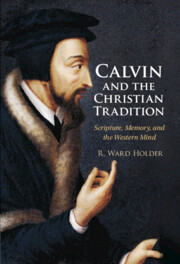54 results
Bibliography
-
- Book:
- Calvin and the Christian Tradition
- Published online:
- 26 May 2022
- Print publication:
- 09 June 2022, pp 257-284
-
- Chapter
- Export citation
Index
-
- Book:
- Calvin and the Christian Tradition
- Published online:
- 26 May 2022
- Print publication:
- 09 June 2022, pp 285-296
-
- Chapter
- Export citation
A Note on Translations
-
- Book:
- Calvin and the Christian Tradition
- Published online:
- 26 May 2022
- Print publication:
- 09 June 2022, pp xi-xii
-
- Chapter
- Export citation
6 - Tradition as a Historiographical and Cultural Problem
-
- Book:
- Calvin and the Christian Tradition
- Published online:
- 26 May 2022
- Print publication:
- 09 June 2022, pp 203-231
-
- Chapter
- Export citation
Acknowledgments
-
- Book:
- Calvin and the Christian Tradition
- Published online:
- 26 May 2022
- Print publication:
- 09 June 2022, pp ix-x
-
- Chapter
- Export citation
1 - What Is Tradition?
-
- Book:
- Calvin and the Christian Tradition
- Published online:
- 26 May 2022
- Print publication:
- 09 June 2022, pp 20-40
-
- Chapter
- Export citation
4 - Calvin, Tradition, and Vernacular Works
-
- Book:
- Calvin and the Christian Tradition
- Published online:
- 26 May 2022
- Print publication:
- 09 June 2022, pp 123-142
-
- Chapter
- Export citation
3 - Calvin, Tradition, and Polemics
-
- Book:
- Calvin and the Christian Tradition
- Published online:
- 26 May 2022
- Print publication:
- 09 June 2022, pp 68-122
-
- Chapter
- Export citation
Contents
-
- Book:
- Calvin and the Christian Tradition
- Published online:
- 26 May 2022
- Print publication:
- 09 June 2022, pp vii-viii
-
- Chapter
- Export citation
2 - Calvin, Tradition, and Exegesis
-
- Book:
- Calvin and the Christian Tradition
- Published online:
- 26 May 2022
- Print publication:
- 09 June 2022, pp 41-67
-
- Chapter
- Export citation
Dedication
-
- Book:
- Calvin and the Christian Tradition
- Published online:
- 26 May 2022
- Print publication:
- 09 June 2022, pp v-vi
-
- Chapter
- Export citation
Copyright page
-
- Book:
- Calvin and the Christian Tradition
- Published online:
- 26 May 2022
- Print publication:
- 09 June 2022, pp iv-iv
-
- Chapter
- Export citation
Introduction
-
- Book:
- Calvin and the Christian Tradition
- Published online:
- 26 May 2022
- Print publication:
- 09 June 2022, pp 1-19
-
- Chapter
- Export citation
Epilogue
-
- Book:
- Calvin and the Christian Tradition
- Published online:
- 26 May 2022
- Print publication:
- 09 June 2022, pp 232-256
-
- Chapter
- Export citation
5 - Calvin, Tradition, and Doctrine
-
- Book:
- Calvin and the Christian Tradition
- Published online:
- 26 May 2022
- Print publication:
- 09 June 2022, pp 143-202
-
- Chapter
- Export citation
A Note on Language
-
- Book:
- Calvin and the Christian Tradition
- Published online:
- 26 May 2022
- Print publication:
- 09 June 2022, pp xiii-xiv
-
- Chapter
- Export citation
Abbreviations
-
- Book:
- Calvin and the Christian Tradition
- Published online:
- 26 May 2022
- Print publication:
- 09 June 2022, pp xv-xvi
-
- Chapter
- Export citation

Calvin and the Christian Tradition
- Scripture, Memory, and the Western Mind
-
- Published online:
- 26 May 2022
- Print publication:
- 09 June 2022
Debating the Sacraments: Print and Authority in the Early Reformation. By Amy Nelson Burnett. Oxford: Oxford University Press, 2019. xx + 524 pp. $99.00 cloth.
-
- Journal:
- Church History / Volume 89 / Issue 2 / June 2020
- Published online by Cambridge University Press:
- 02 October 2020, pp. 459-461
- Print publication:
- June 2020
-
- Article
- Export citation
Copyright page
-
- Book:
- John Calvin in Context
- Published online:
- 14 November 2019
- Print publication:
- 05 December 2019, pp iv-iv
-
- Chapter
- Export citation



